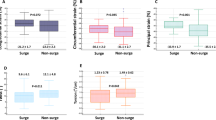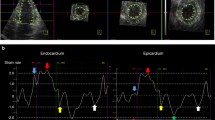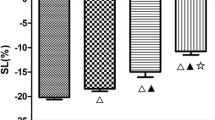Abstract
To assess the presence of subclinical left ventricular myocardial dysfunction in subjects with high-normal blood pressure (BP) and untreated arterial hypertension, using three-dimensional (3D) echocardiography strain analysis. This cross-sectional study included 49 subjects with optimal BP, 50 subjects with high-normal BP, and 50 newly diagnosed untreated hypertensive patients matched by gender and age. All the subjects underwent 24 h blood pressure monitoring and complete two-dimensional and 3D echocardiography examination. The enrolled subjects were grouped according to 24 h systolic BP values, dividing the subjects with optimal BP from those with high-normal BP and the hypertensive patients (cut-off values were 120 and 130 mmHg, respectively). 3D global longitudinal strain was significantly lower in the high-normal BP group and the hypertensive patients, in comparison with the optimal BP group (−20.5 ± 3.3 vs. −18.7 ± 2.8 vs. −17.6 ± 2.7 %, p < 0.001). Similar results were obtained for 3D global circumferential strain (−18.6 ± 3 vs. −17.1 ± 2.9 vs. −16 ± 2.5 %, p < 0.001), as well for 3D global radial strain (49.4 ± 9.5 vs. 44.7 ± 8.1 vs. 43.5 ± 7.8 %, p = 0.002), and global area strain (−31.2 ± 4.8 vs. −28.7 ± 4.2 vs. −27.1 ± 4.5 %, p < 0.001). LV twist was increased in the hypertensive patients in comparison with the high-normal and the optimal BP groups (10.1° ± 2.4° vs. 10.8° ± 2.6° vs. 13.8° ± 3.1°, p < 0.01), whereas untwisting rate significantly and gradually decreased from the optimal BP group, across the high-normal BP group, to the hypertensive patients (−135 ± 35 vs. −118 ± 31 vs. −102 ± 27°/s, p < 0.001). 3D echocardiography revealed that the subjects with high-normal BP suffered subclinical impairment of LV mechanics similar as the hypertensive patients.





Similar content being viewed by others
References
Lewington S, Clarke R, Qizilbash N, Peto R, Collins R, Prospective Studies Collaboration (2002) Age-specific relevance of usual blood pressure to vascular mortality: a meta-analysis of individual data for one million adults in 61 prospective studies. Lancet 360:1903–1913
Chobanian AV, Bakris GL, Black HR, Cushman WC, Green LA, Izzo JL Jr et al (2003) Joint national committee on prevention, detection, evaluation, and treatment of high blood pressure. National heart, lung, and blood institute; national high blood pressure education program coordinating committee. Seventh report of the joint national committee on prevention, detection, evaluation, and treatment of high blood pressure. Hypertension 42:1206–1252
Mancia G, Fagard R, Narkiewicz K, Redón J, Zanchetti A, Böhm M et al (2013) 2013 ESH/ESC Guidelines for the management of arterial hypertension: the Task Force for the management of arterial hypertension of the European Society of Hypertension (ESH) and of the European Society of Cardiology (ESC). J Hypertens 31(7):1281–1357
Guo X, Zou L, Zhang X, Li J, Zheng L, Sun Z et al (2011) Prehypertension: a meta-analysis of the epidemiology, risk factors, and predictors of progression. Tex Heart Inst J 38(6):643–652
Kim SH, Cho GY, Baik I, Lim SY, Choi CU, Lim HE et al (2011) Early abnormalities of cardiovascular structure and function in middle-aged Korean adults with prehypertension: the Korean Genome Epidemiology study. Am J Hypertens 24(2):218–224
Doğru MT, Tireli E, Güneri M, Iyisoy A, Celik T (2008) Differences in left ventricular structure, functions and elastance in the patients with normotensive blood pressure. Anadolu Kardiyol Derg 8(6):413–421
Pedrinelli R, Canale ML, Giannini C, Talini E, Penno G, Dell’Omo G et al (2010) Right ventricular dysfunction in early systemic hypertension: a tissue Doppler imaging study in patients with high-normal and mildly increased arterial blood pressure. J Hypertens 28(3):615–621
Vasan RS, Larson MG, Leip EP, Evans JC, O’Donnell CJ, Kannel WB et al (2001) Impact of high-normal blood pressure on the risk of cardiovascular disease. N Engl J Med 345:1291–1297
Lang RM, Bierig M, Devereux RB, Flachskampf FA, Foster E, Pellikka PA, American Society of Echocardiography’s Nomenclature and Standards Committee, American College of Cardiology Echocardiography Committee, American Heart Association, European Association of Echocardiography, European Society of Cardiology et al (2006) Recommendations for chamber quantification. Eur J Echocardiogr 7:79–108
de Simone G, Daniels SR, Devereux RB, Meyer RA, Roman MJ, de Divitiis O et al (1992) Left ventricular mass and body size in normotensive children and adults: assessment of allometric relations and impact of overweight. J Am Coll Cardiol 20(5):1251–1260
Quinones MA, Otto CM, Stoddard M, Waggoner A, Zoghbi WA, Doppler Quantification Task Force of the Nomenclature and Standards Committee of the American Society of Echocardiography (2002) Recommendations for quantification of Doppler echocardiography: a report from the Doppler quantification task force of the nomenclature and standards committee of the American Society of Echocardiography. J Am Soc Echocardiogr 15:167–184
Tei C, Ling LH, Hodge DO, Bailey KR, Oh JK, Rodeheffer RJ et al (1995) New index of combined systolic and diastolic myocardial performance: a simple and reproducible measure of cardiac function-a study in normals and dilated cardiomyopathy. J Cardiol 26:357–366
Abraham TP, Dimaano VL, Liang HY (2007) Role of tissue Doppler and strain echocardiography in current clinical practice. Circulation 116:2597–2609
Perk G, Tunick PA, Kronzon I (2007) Non-Doppler two-dimensional strain imaging by echocardiography—from technical considerations to clinical applications. J Am Soc Echocardiogr 20:234–243
van Dalen BM, Soliman OI, Vletter WB, Kauer F, van der Zwaan HB, ten Cate FJ et al (2009) Feasibility and reproducibility of left ventricular rotation parameters measured by speckle tracking echocardiography. Eur J Echocardiogr 10:669–676
Notomi Y, Lysyansky P, Setser RM, Shiota T, Popović ZB, Martin-Miklovic MG et al (2005) Measurement of ventricular torsion by two-dimensional ultrasound speckle tracking imaging. J Am Coll Cardiol 45:2034–2041
Biswas M, Sudhakar S, Nanda NC, Buckberg G, Pradhan M, Roomi AU et al (2013) Two- and three-dimensional speckle tracking echocardiography: clinical applications and future directions. Echocardiography 30(1):88–105
Mizuguchi Y, Oishi Y, Miyoshi H, Iuchi A, Nagase N, Oki T (2010) Concentric left ventricular hypertrophy brings deterioration of systolic longitudinal, circumferential, and radial myocardial deformation in hypertensive patients with preserved left ventricular pump function. J Cardiol 55(1):23–33
Miyoshi H, Oishi Y, Mizuguchi Y, Iuchi A, Nagase N, Ara N et al (2013) Effect of an increase in left ventricular pressure overload on left atrial-left ventricular coupling in patients with hypertension: a two-dimensional speckle tracking echocardiographic study. Echocardiography 30(6):658–666
Goebel B, Gjesdal O, Kottke D, Otto S, Jung C, Lauten A et al (2011) Detection of irregular patterns of myocardial contraction in patients with hypertensive heart disease: a two-dimensional ultrasound speckle tracking study. J Hypertens 29(11):2255–2264
Imbalzano E, Zito C, Carerj S, Oreto G, Mandraffino G, Cusmà-Piccione M et al (2011) Left ventricular function in hypertension: new insight by speckle tracking echocardiography. Echocardiography 28(6):649–657
Narayanan A, Aurigemma GP, Chinali M, Hill JC, Meyer TE, Tighe DA (2009) Cardiac mechanics in mild hypertensive heart disease: a speckle-strain imaging study. Circ Cardiovasc Imaging 2(5):382–390
Di Bello V, Talini E, Dell’Omo G, Giannini C, Delle Donne MG, Canale ML et al (2010) Early left ventricular mechanics abnormalities in prehypertension: a two-dimensional strain echocardiography study. Am J Hypertens 23(4):405–412
Galderisi M, Lomoriello VS, Santoro A, Esposito R, Olibet M, Raia R et al (2010) Differences of myocardial systolic deformation and correlates of diastolic function in competitive rowers and young hypertensives: a speckle-tracking echocardiography study. J Am Soc Echocardiogr 23(11):1190–1198
Takamura T, Dohi K, Onishi K, Tanabe M, Sugiura E, Nakajima H et al (2010) Left ventricular contraction-relaxation coupling in normal, hypertrophic, and failing myocardium quantified by speckle-tracking global strain and strain rate imaging. J Am Soc Echocardiogr 23(7):747–754
Kang SJ, Lim HS, Choi B, Choi SY, Yoon MH, Hwang GS et al (2008) Longitudinal strain and torsion assessed by two-dimensional speckle tracking correlate with the serum level of tissue inhibitor of matrix metalloproteinase-1, a marker of myocardial fibrosis, in patients with hypertension. J Am Soc Echocardiogr 21:907–911
Burns AT, La Gerche A, Prior DL, Macisaac AI (2009) Left ventricular untwisting is an important determinant of early diastolic function. JACC Cardiovasc Imaging 2(6):709–716
Ahmed MI, Desai RV, Gaddam KK, Venkatesh BA, Agarwal S, Inusah S et al (2012) Relation of torsion and myocardial strains to LV ejection fraction in hypertension. JACC Cardiovasc Imaging 5(3):273–281
Saltijeral A, Perez de Isla L, Veras K, Fernandez Mde J, Gorissen W, Rementeria J et al (2010) Myocardial strain characterization in different left ventricular adaptative responses to high blood pressure: a study based on 3D-wall motion tracking analysis. Echocardiography 27(10):1238–1246
Santoro A, Caputo M, Antonelli G, Lisi M, Padeletti M, D’Ascenzi F et al (2011) Left ventricular twisting as determinant of diastolic function: a speckle tracking study in patients with cardiac hypertrophy. Echocardiography 28(8):892–898
Maharaj N, Khandheria BK, Peters F, Libhaber E, Essop MR (2013) Time to twist: marker of systolic dysfunction in Africans with hypertension. Eur Heart J Cardiovasc Imaging 14(4):358–365
Takeuchi M, Borden WB, Nakai H, Nishikage T, Kokumai M, Nagakura T et al (2007) Reduced and delayed untwisting of the left ventricle in patients with hypertension and left ventricular hypertrophy: a study using two-dimensional speckle tracking imaging. Eur Heart J 28(22):2756–2762
Galderisi M, Esposito R, Schiano-Lomoriello V, Santoro A, Ippolito R, Schiattarella P et al (2012) Correlates of global area strain in native hypertensive patients: a three-dimensional speckle-tracking echocardiography study. Eur Heart J Cardiovasc Imaging 13(9):730–738
Pacileo G, Castaldi B, Di Salvo G, Limongelli G, Rea A, D’Andrea A, Russo MG, Calabrò R (2013) Assessment of left-ventricular mass and remodeling in obese adolescents: M-mode, 2D or 3D echocardiography? J Cardiovasc Med (Hagerstown) 14(2):144–149
Shimada YJ, Shiota T (2012) Meta-analysis of accuracy of left ventricular mass measurement by three-dimensional echocardiography. Am J Cardiol 110(3):445–452
Saito K, Okura H, Watanabe N, Hayashida A, Obase K, Imai K, Maehama T, Kawamoto T, Neishi Y, Yoshida K (2009) Comprehensive evaluation of left ventricular strain using speckle tracking echocardiography in normal adults: comparison of three-dimensional and two-dimensional approaches. J Am Soc Echocardiogr 22(9):1025–1030
Altman M, Bergerot C, Aussoleil A, Davidsen ES, Sibellas F, Ovize M, Bonnefoy-Cudraz E, Thibault H, Derumeaux G (2013) Assessment of left ventricular systolic function by deformation imaging derived from speckle tracking: a comparison between 2D and 3D echo modalities. Eur Heart J Cardiovasc Imaging (Epub ahead of print)
Tadic M, Cuspidi C, Majstorovic A, Sljivic A, Pencic B, Ivanovic B, Scepanovic R, Kocijancic V, Celic V (2013) Does a nondipping pattern influence left ventricular and left atrial mechanics in hypertensive patients? J Hypertens 31(12):2438–2446
Yodwut C, Lang RM, Weinert L, Ahmad H, Mor-Avi V (2013) Three-dimensional echocardiographic quantitative evaluation of left ventricular diastolic function using analysis of chamber volume and myocardial deformation. Int J Cardiovasc Imaging 29(2):285–293
Kouzu H, Yuda S, Muranaka A, Doi T, Yamamoto H, Shimoshige S, Hase M, Hashimoto A, Saitoh S, Tsuchihashi K, Miura T, Watanabe N, Shimamoto K (2011) Left ventricular hypertrophy causes different changes in longitudinal, radial, and circumferential mechanics in patients with hypertension: a two-dimensional speckle tracking study. J Am Soc Echocardiogr 24(2):192–199
Kleijn SA, Aly MF, Terwee CB, van Rossum AC, Kamp O (2011) Three-dimensional speckle tracking echocardiography for automatic assessment of global and regional left ventricular function based on area strain. J Am Soc Echocardiogr 24(3):314–321
Badano L, Cucchini U, Muraru D, Al Nono O, Sarais C, Iliceto S (2013) Use of three-dimensional speckle tracking to assess left ventricular myocardial mechanics: inter-vendor consistency and reproducibility of strain meauserements. Eur Heart J Cardiovasc Imaging 14:285–293
Conflict of interest
None.
Author information
Authors and Affiliations
Corresponding author
Rights and permissions
About this article
Cite this article
Tadic, M., Majstorovic, A., Pencic, B. et al. The impact of high-normal blood pressure on left ventricular mechanics: a three-dimensional and speckle tracking echocardiography study. Int J Cardiovasc Imaging 30, 699–711 (2014). https://doi.org/10.1007/s10554-014-0382-3
Received:
Accepted:
Published:
Issue Date:
DOI: https://doi.org/10.1007/s10554-014-0382-3




